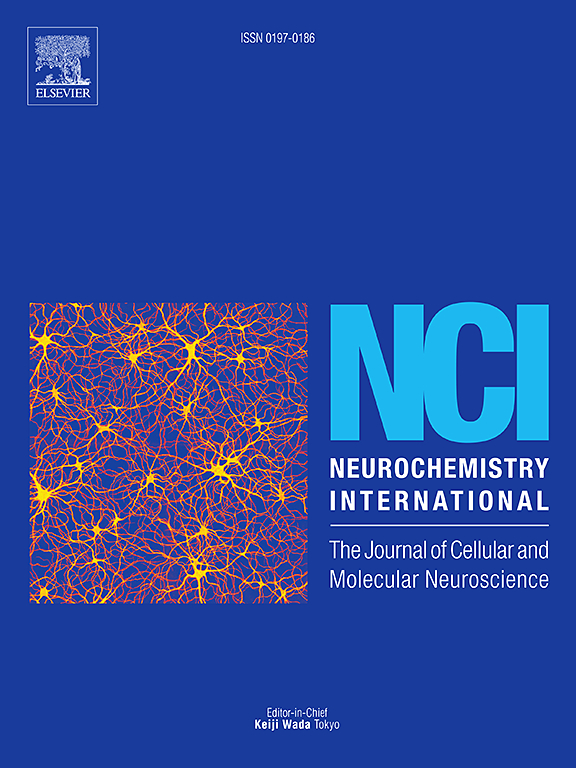Morphine self-administration decreases intrinsic excitability of accumbal medium spiny neurons and suppresses the innate immune system in male Wistar rats
IF 4
3区 医学
Q2 BIOCHEMISTRY & MOLECULAR BIOLOGY
引用次数: 0
Abstract
Introduction
Morphine alleviates severe pain but is addictive and associated with weakened immune system. Interestingly, the immunosuppressive effects have been linked to central circuits including the nucleus accumbens shell (NAc), suggesting that there might be a direct link between reward processing in the NAc and weakened immune system. The overall aim with this study was to assess the impact displayed by morphine self-administration on neuroplasticity in the NAc shell and circulating white blood cells.
Methods
Wistar rats received morphine injections over ten days, and locomotor activity was monitored. Next, morphine self-administration, and relapse drinking after forced abstinence, were assessed. Lastly, electrophysiological recordings were conducted in the NAc ex vivo to define neurophysiological adaptations, and hematological analysis were conducted in parallel.
Results
While ten days of morphine injections were not sufficient to affect morphine self-administration, behavioral sensitization to the locomotor stimulatory properties of morphine was observed and further correlated with the amount of morphine consumed following forced abstinence. Electrophysiological slice recordings demonstrated no effect on excitatory neurotransmission, but the intrinsic excitability of NAc neurons was significantly depressed compared to water drinking controls. In addition, hematological analysis demonstrated a significant decline in the number of white blood cells, especially monocytes and neutrophils, while erythrocytes were not affected. The amount of circulating white blood cells further correlated with morphine intake, but not with neurophysiological parameters.
Conclusion
The data presented here demonstrates that morphine self-administration produces accumbal neuroplasticity and biological transformations that could contribute to the addictive and immunosuppressive properties of morphine.

吗啡自我给药降低雄性Wistar大鼠伏隔中棘神经元的内在兴奋性,抑制先天免疫系统
吗啡能减轻剧烈疼痛,但容易上瘾,并与免疫系统减弱有关。有趣的是,免疫抑制效应与包括伏隔核壳(NAc)在内的中枢回路有关,这表明在NAc的奖励处理和免疫系统减弱之间可能存在直接联系。本研究的总体目的是评估吗啡自我给药对NAc外壳和循环白细胞的神经可塑性的影响。方法给大鼠注射吗啡10 d,观察大鼠的运动活动。接下来,评估吗啡自我给药和强制戒断后的复饮。最后,在离体NAc中进行电生理记录以确定神经生理适应,同时进行血液学分析。结果虽然10天的吗啡注射不足以影响吗啡的自我给药,但观察到吗啡对运动刺激特性的行为致敏,并进一步与强制戒断后吗啡摄入量相关。电生理切片记录显示对兴奋性神经传递没有影响,但与饮水对照组相比,NAc神经元的固有兴奋性明显降低。此外,血液学分析显示白细胞,特别是单核细胞和中性粒细胞的数量明显下降,而红细胞不受影响。循环白细胞的数量进一步与吗啡摄入量相关,但与神经生理参数无关。结论吗啡自我给药可引起伏隔神经可塑性和生物转化,这可能与吗啡的成瘾性和免疫抑制特性有关。
本文章由计算机程序翻译,如有差异,请以英文原文为准。
求助全文
约1分钟内获得全文
求助全文
来源期刊

Neurochemistry international
医学-神经科学
CiteScore
8.40
自引率
2.40%
发文量
128
审稿时长
37 days
期刊介绍:
Neurochemistry International is devoted to the rapid publication of outstanding original articles and timely reviews in neurochemistry. Manuscripts on a broad range of topics will be considered, including molecular and cellular neurochemistry, neuropharmacology and genetic aspects of CNS function, neuroimmunology, metabolism as well as the neurochemistry of neurological and psychiatric disorders of the CNS.
 求助内容:
求助内容: 应助结果提醒方式:
应助结果提醒方式:


